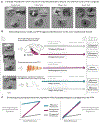When the ventral visual stream is not enough: A deep learning account of medial temporal lobe involvement in perception
- PMID: 34265252
- PMCID: PMC10870832
- DOI: 10.1016/j.neuron.2021.06.018
When the ventral visual stream is not enough: A deep learning account of medial temporal lobe involvement in perception
Abstract
The medial temporal lobe (MTL) supports a constellation of memory-related behaviors. Its involvement in perceptual processing, however, has been subject to enduring debate. This debate centers on perirhinal cortex (PRC), an MTL structure at the apex of the ventral visual stream (VVS). Here we leverage a deep learning framework that approximates visual behaviors supported by the VVS (i.e., lacking PRC). We first apply this approach retroactively, modeling 30 published visual discrimination experiments: excluding non-diagnostic stimulus sets, there is a striking correspondence between VVS-modeled and PRC-lesioned behavior, while each is outperformed by PRC-intact participants. We corroborate and extend these results with a novel experiment, directly comparing PRC-intact human performance to electrophysiological recordings from the macaque VVS: PRC-intact participants outperform a linear readout of high-level visual cortex. By situating lesion, electrophysiological, and behavioral results within a shared computational framework, this work resolves decades of seemingly inconsistent findings surrounding PRC involvement in perception.
Keywords: biologically plausible computational models; convolutional neural network; electrophysiological; lesion; medial temporal lobe; memory; perception; perirhinal cortex; ventral visual stream.
Copyright © 2021 Elsevier Inc. All rights reserved.
Conflict of interest statement
Declaration of interests The authors declare no competing interests.
Figures





Comment in
-
Perception and memory in the medial temporal lobe: Deep learning offers a new lens on an old debate.Neuron. 2021 Sep 1;109(17):2643-2645. doi: 10.1016/j.neuron.2021.08.018. Neuron. 2021. PMID: 34473951
References
-
- Abadi M, Barham P, Chen J, Chen Z, Davis A, Dean J, Devin M, Ghemawat S, Irving G, Isard M, and Kudlur M (2016). Tensorflow: A system for large-scale machine learning. 12th {USENIX} symposium on operating systems design and implementation 16 (OSDI; ), pp. 265–283.
-
- Aggleton JP, and Brown MW (2006). Interleaving brain systems for episodic and recognition memory. Trends Cogn. Sci 10, 455–463. - PubMed
-
- Barense MD, Gaffan D, and Graham KS (2007). The human medial temporal lobe processes online representations of complex objects. Neuropsychologia 45, 2963–2974. - PubMed
-
- Bashivan P, Kar K, and DiCarlo JJ (2019). Neural population control via deep image synthesis. Science 364, eaav9436. - PubMed
Publication types
MeSH terms
Grants and funding
LinkOut - more resources
Full Text Sources
Miscellaneous

